“I wrote my father a very long letter ... on the pains I had taken to bring the Indigo, Ginger, Cotton, Lucern, and Cassada to perfection, and had greater hopes from the Indigo....”
To her father: “The Cotton, Guiney corn and most of the Ginger planted here was cutt off by a frost.”
“I wrote you in former letters we had a fine crop of Indigo Seed upon the ground and since informed you the frost took it before it was dry. I picked out the best of it and had it planted but there is not more than a hundred bushes of it come up, which proves the more unlucky as you have sent a man to make it.”
In a letter to a friend she indicates how busy she is:
“In genl I rise at five o’clock in the morning, read till seven—then take a walk in the garden or fields, see that the Servants are at their respective business, then to breakfast. The first hour after breakfast is spent in musick, the next is constantly employed in recolecting something I have learned, ... such as french and shorthand. After that I devote the rest of the time till I dress for dinner, to our little Polly, and two black girls, who I teach to read.... The first hour after dinner, as ... after breakfast, at musick, the rest of the afternoon in needlework till candle light, and from that time to bed time read or write; ... Thursday, the whole day except what the necessary affairs of the family take up, is spent in writing, either on the business of the plantations or on letters to my friends...."[302]
And yet this mere girl found time to devote to the general conventional activities of women. After her marriage she seems to have gained her greatest pleasure from her devotion to her household; but, left a widow at thirty-six, she once more was forced to undertake the management of a great plantation. The same executive genius again appeared, and an initiative certainly surpassing that of her neighbors. She introduced into South Carolina the cultivation of Indigo, and through her foresight and efforts “it continued the chief highland staple of the country for more than thirty years.... Just before the Revolution the annual export amounted to the enormous quantity of one million, one hundred and seven thousand, six hundred and sixty pounds. When will ‘New Woman’ do more for her country?"[303]
Martha Washington was another of the colonial women who showed not only tact but considerable talent in conducting personally the affairs of her large estate between the death of her first husband and her marriage to Washington, and when the General went on his prolonged absences to direct the American army, she, with some aid from Lund Washington, attended with no small success to the Mount Vernon property.
III. Woman’s Legal Powers




